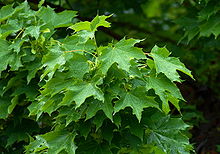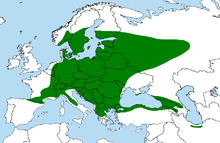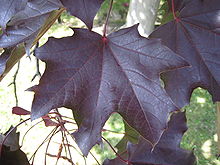- Acer platanoides
-
Acer platanoides 
Norway Maple leaves Scientific classification Kingdom: Plantae (unranked): Angiosperms (unranked): Eudicots (unranked): Rosids Order: Sapindales Family: Sapindaceae[1] Genus: Acer Species: A. platanoides Binomial name Acer platanoides
L.
Native Distribution Acer platanoides (Norway Maple) is a species of maple native to eastern and central Europe and southwest Asia, from France east to Russia, north to southern Scandinavia and southeast to northern Iran.[2][3]
It is a deciduous tree growing to 20–30 m tall with a trunk up to 1.5 m diameter, and a broad, rounded crown. The bark is grey-brown and shallowly grooved; unlike many other maples, mature trees do not tend to develop a shaggy bark. The shoots are green at first, soon becoming pale brown; the winter buds are shiny red-brown. The leaves are opposite, palmately lobed with five lobes, 7–14 cm long and 8–20 cm (rarely 25 cm) across; the lobes each bear one to three side teeth, and an otherwise smooth margin. The leaf petiole is 8–20 cm long, and secretes a milky juice when broken. The autumn colour is usually yellow, occasionally orange-red. The flowers are in corymbs of 15–30 together, yellow to yellow-green with five sepals and five petals 3–4 mm long; flowering occurs in early spring before the new leaves emerge. The fruit is a double samara with two winged seeds; the seeds are disc-shaped, strongly flattened, 10–15 mm across and 3 mm thick. The wings are 3–5 cm long, widely spread, approaching a 180° angle. It typically produces a large quantity of viable seeds. It is not particularly a long-lived tree, with a maximum age of around 250 years.[4][5][6][7]
Contents
Classification and identification
 Norway Maple bark.
Norway Maple bark.
Norway Maple is a member (and is the type species) of the section Platanoidea Pax, characterised by flattened, disc-shaped seeds and the shoots and leaves containing milky sap. Other related species in this section include Acer campestre (Field Maple), Acer cappadocicum (Cappadocian Maple), Acer lobelii (Lobel's Maple), and Acer truncatum (Shandong Maple). From Field Maple, Norway Maple is distinguished by its larger leaves with pointed, not blunt, lobes, and from the other species by the presence of one or more teeth on all of the lobes.[4][5]
It is also frequently confused with the more distantly related Acer saccharum (Sugar Maple). Sugar Maple is easy to identify by clear sap in the petiole (Norway Maple has white sap). The tips of the points on Norway Maple leaves reduce to a fine "hair", while the tips of the points on Sugar Maple leaves are on close inspection rounded. On mature trees, Sugar Maple bark is more shaggy, while Norway Maple bark has small, often criss-crossing grooves. While the shape and angle of leaf lobes vary somewhat within all Maple species, the leaf lobes of Norway Maple tend to have a more triangular shape, in contrast to the more squarish lobes often seen on Sugar Maples. The seeds of Sugar Maple are globose, while Norway Maple seeds are flattened. Sugar Maple usually has a brighter orange autumn color, where Norway Maple is usually yellow, although some of the red-leaved cultivars appear more orange. The tree tends to leaf out earlier than most maples and holds its leaves somewhat longer in autumn.[4][5]
Cultivation and uses
The wood is hard, yellowish-white to pale reddish, with the heartwood not distinct; it is used for furniture and turnery.[8]
It has been widely placed into cultivation in other areas, including western Europe northwest of its native range. It grows north of the Arctic Circle at Tromsø, Norway. In North America, it is grown as a street and shade tree as far north as Anchorage, Alaska.[9] It is favoured due to its tall trunk and tolerance of poor, compacted soils and urban pollution.
It is becoming a popular species for Bonsai in Europe and is used for medium to large Bonsai Sizes and a multitude of styles. [10]
Cultivars
Many cultivars have been selected, with distinctive leaf shape or coloration such as the dark purple of 'Crimson King' and 'Schwedleri', the variegated leaves of 'Drummondii' and 'Emerald Queen', and the deeply divided, feathery leaves of 'Dissectum' and 'Lorbergii'. The purple-foliage cultivars have orange to red autumn colour. 'Columnare' is selected for its narrow upright growth.[5][11]
- Weeping Norway Maple, Acer platanoides 'Pendulum'
As an Invasive Species in North America
Unfortunately, despite its good looks and urban hardiness, it releases chemicals to discourage undergrowth[12] which tends to create bare, muddy run-off conditions immediately under the tree. A. platanoides has been shown to inhibit the growth of native saplings as a canopy tree or as a sapling.[13] Norway maple also suffers less herbivory than sugar maple, allowing it to gain a competitive advantage against the latter species.[14] As a result of these characteristics it is considered invasive in some states[15] and has been banned in New Hampshire and Massachusetts.[16][17] Norway Maple is one of three species that Meijer Garden Centers no longer sell; Meijer made this decision due to the tree's invasive nature.[18] Despite these steps, Norway Maple is still available and widely used for urban plantings in many areas.
Natural Enemies of Norway Maple
Norway Maple itself is threatened in a few areas by the Asian long-horned beetle, which eats through the trunk of trees, often killing them.
A number of species of Lepidoptera feed on Norway Maple foliage; see Lepidoptera that feed on maples. Norway Maple is generally free of serious diseases, though can be attacked by the powdery mildew Uncinula bicornis, and verticillium wilt disease caused by Verticillium spp.[19]
References
- ^ Stevens, P. F. (2001 onwards). Angiosperm Phylogeny Website. Version 9, June 2008 [and more or less continuously updated since]. http://www.mobot.org/MOBOT/research/APweb/.
- ^ Flora Europaea: Acer platanoides distribution
- ^ Den virtuella floran: Acer platanoides distribution
- ^ a b c Rushforth, K. (1999). Trees of Britain and Europe. Collins ISBN 0-00-220013-9.
- ^ a b c d Mitchell, A. F. (1974). A Field Guide to the Trees of Britain and Northern Europe. Collins ISBN 0-00-212035-6
- ^ Mitchell, A. F. (1982). The Trees of Britain and Northern Europe. Collins ISBN 0-00-219037-0
- ^ Norwegian Botanical Association: Acer platanoides photos
- ^ Vedel, H., & Lange, J. (1960). Trees and Bushes in Wood and Hedgerow. Metheun & Co. Ltd., London.
- ^ http://treesneartheirlimitsalaska.blogspot.com/
- ^ D'Cruz, Mark. "Ma-Ke Bonsai Care Guide for Acer platanoides". Ma-Ke Bonsai. http://makebonsai.com/guide/bonsailink.asp?quicklink=5038&name=Acer_platanoides. Retrieved 2011-7-5.
- ^ Huxley, A., ed. (1992). New RHS Dictionary of Gardening. Macmillan ISBN 0-333-47494-5.
- ^ http://www.toronto.ca/trees/pdfs/Fact_3_Controlling_Invasive_Plants.pdf
- ^ Shannon L. Galbraith-Kent and Steven N. Handel (2008). "Invasive Acer platanoides inhibits native sapling growth in forest understorey communities". Journal of Ecology 96 (2): 293–302. doi:10.1111/j.1365-2745.2007.01337.x.
- ^ C. L. Cincotta, J. M. Adams, C. Holzapfel (2009). "Testing the enemy release hypothesis: a comparison of foliar insect herbivory of the exotic Norway maple (Acer platanoides L.) and the native sugar maple (A. saccharum L.)". Biol Invasions. http://newarkbioweb.rutgers.edu/Holzapfel%20Lab/Main%20Pages/People/people%20pages/Claus/claus%20pdf/8402%20Cincotta%20Norway%20Maple%20BioInv.%202008.pdf.
- ^ Swearingen, J., Reshetiloff, K., Slattery, B., & Zwicker, S. (2002). "Norway Maple". Plant Invaders of Mid-Atlantic Natural Areas. National Park Service and U.S. Fish & Wildlife Service. http://www.nps.gov/plants/alien/pubs/midatlantic/acpl.htm.
- ^ Carol Ness. "Norway Maple". Virginia Cooperative Extension. http://pubs.ext.vt.edu/2901/2901-1059/2901-1059.html.
- ^ Sally Kerans (May 31, 2007). "Invasive plants: Old standards get bad name". Danvers Herald. http://www.wickedlocal.com/danvers/fun/gardening/x546950923.
- ^ The Nature Conservancy. "The Nature Conservancy and Meijer Encourage Non-Invasive Plants". The Nature Conservancy. http://www.nature.org/newsfeatures/media/pressreleases/the-nature-conservancy-and-meijer-encourage-non-invasive-plants.xml.
- ^ Phillips, D. H., & Burdekin, D. A. (1992). Diseases of Forest and Ornamental Trees. Macmillan ISBN 0-333-49493-8.
External links
-
Fruit of Acer saccharum for comparison, much smaller and differently oriented
Categories:- Invasive plant species
- Acer
- Trees of humid continental climate
- Flora of Afghanistan
- Trees of Iran
- Flora of Armenia
- Flora of Azerbaijan
- Trees of Russia
- Flora of Macedonia
- Flora of Norway
- Flora of Germany
- Flora of Estonia
- Flora of Lithuania
- Flora of Latvia
- Flora of Greece
- Trees of Italy
- Flora of France
- Trees of Spain
- Trees of Asia
- Trees of the Middle East
Wikimedia Foundation. 2010.








